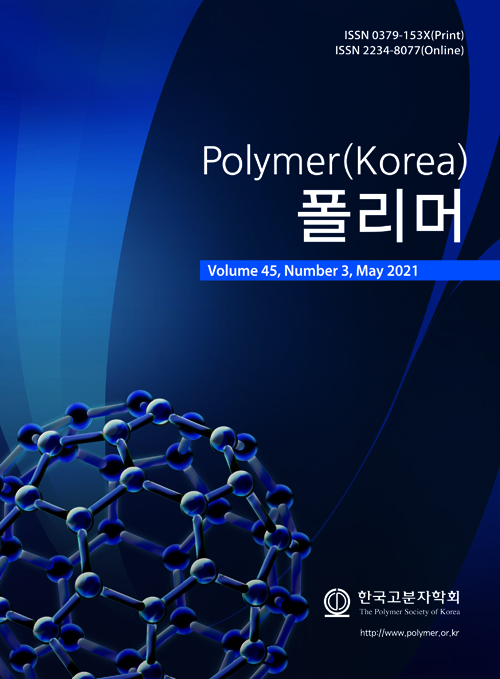- Analysis of Foaming Characteristics and Physical Properties of Polyurethane Foam according to Foaming Agents
Department of Chemical Engineering, Kyonggi University, Suwon 16227, Korea
- 발포제에 따른 폴리우레탄 폼의 발포 특성 및 물성 분석
경기대학교 화학공학과
Reproduction, stored in a retrieval system, or transmitted in any form of any part of this publication is permitted only by written permission from the Polymer Society of Korea.
In this study, we synthesized rigid polyurethane foam using water, HCFC-141b, HFC-245fa, HFO-1233zd, and HFO-1336mzz and analyzed the effect of each blowing agent on the foam’s thermal and physical properties. It was confirmed that the loss rate of a blowing agent during blowing process is affected by gas generation rate of the blowing agent, the foam’s maximum temperature, and the rate of its temperature rise. Foam with smaller cells showed greater compressive strength, and foam produced using HFO-1233zd showed high insulation performance due to small cells and low gas thermal conductivity. However, the foam’s glass transition temperature decreased as time passed due to the plasticizing effect of HFO-1233zd. Through various analysis, it was confirmed that HFO-1233zd and HFO-1336mzz are suitable for replacing HFC-based blowing agents
본 연구에서는 물, HCFC-141b, HFC-245fa, HFO-1233zd, HFO-1336mzz를 사용하여 경질 폴리우레탄 폼을 합성하였고 각각의 발포제가 폼의 합성 및 물성에 미치는 영향을 고찰하였다. 폼 합성 과정에서의 발포제 손실률은 발포제의 가스 생성 속도와 폼의 온도 상승 속도 및 최대 온도의 영향을 받는 것을 확인하였다. 폼의 압축강도는 셀 크기가 작을수록 높게 나타났으며 HFO-1233zd를 사용한 폼은 셀 크기가 작고 가스열전도도가 낮아 높은 단열성능을 나타내었다. 하지만, HFO-1233zd의 가소화 작용으로 인해 시간이 경과할수록 폼의 유리전이온도가 감소하는 것을 확인하였다. 다양한 분석을 통해 HFO-1233zd와 HFO-1336mzz가 HFC 계열의 발포제를 대체할 수 있는 발포제로서 적절한 것을 확인하였다
Keywords: rigid polyurethane foam, blowing agent, hydrofluoroolefin, mechanical property, thermal conductivity
- Polymer(Korea) 폴리머
- Frequency : Bimonthly(odd)
ISSN 0379-153X(Print)
ISSN 2234-8077(Online)
Abbr. Polym. Korea - 2023 Impact Factor : 0.4
- Indexed in SCIE
 This Article
This Article
-
2021; 45(3): 406-413
Published online May 25, 2021
- 10.7317/pk.2021.45.3.406
- Received on Dec 8, 2020
- Revised on Jan 12, 2021
- Accepted on Feb 1, 2021
 Correspondence to
Correspondence to
- Sang Bum Kim
-
Department of Chemical Engineering, Kyonggi University, Suwon 16227, Korea
- E-mail: ksb@kyonggi.ac.kr









 Copyright(c) The Polymer Society of Korea. All right reserved.
Copyright(c) The Polymer Society of Korea. All right reserved.